lights HONDA CIVIC 1991 Owners Manual
[x] Cancel search | Manufacturer: HONDA, Model Year: 1991, Model line: CIVIC, Model: HONDA CIVIC 1991Pages: 136, PDF Size: 1.33 MB
Page 16 of 136
![HONDA CIVIC 1991 Owners Manual [Hatchback]
Wearing the Front Seat Berts The automatic ("passive") lap/shoulder belt systems with emer-
gency locking retractors are designed to lock only during a suddenstop or impact. Other HONDA CIVIC 1991 Owners Manual [Hatchback]
Wearing the Front Seat Berts The automatic ("passive") lap/shoulder belt systems with emer-
gency locking retractors are designed to lock only during a suddenstop or impact. Other](/img/13/57901/w960_57901-15.png)
[Hatchback]
Wearing the Front Seat Berts The automatic ("passive") lap/shoulder belt systems with emer-
gency locking retractors are designed to lock only during a suddenstop or impact. Otherwise, they allow you some freedom of move-ment in the seat. The lap/shoulder belt must remain permanently
latched.
NOTE:
The motion sensing lock mechanisms for the front belts are located in each door. Therefore, if a door is opened too quickly, the belt may
lock and the door cannot be opened further. If this happens, close
the door and open it again more slowly. Enter the car and close the door completely.
If a door is not completely closed, the warning lights in the ceiling
and in the instrument panel will come on and the beeper will
sound when the ignition switch is turned on (see page 17).
The driver's seat should be moved to a comfortable distance from
the steering wheel. Sit straight up and well back in the seat.
The seat belt should fit snugly against your body. The shoulder portion of the belt should go over your shoulder and across your
body to evenly distribute the belt's restraining force. Check that the lap portion of the belt is positioned low on your
hipbone and below your abdomen. This way, if the car is involved
in an accident, you will be less likely to slide under the seat belts.
If the belt is too near your neck and throat, move toward the
center of the seat.
Never drive the car with the doors ajar. The front doors must be
closed completely for the front seat belts to function properly.
(cont'd)ProCarManuals.comMain Menu s t
Page 18 of 136
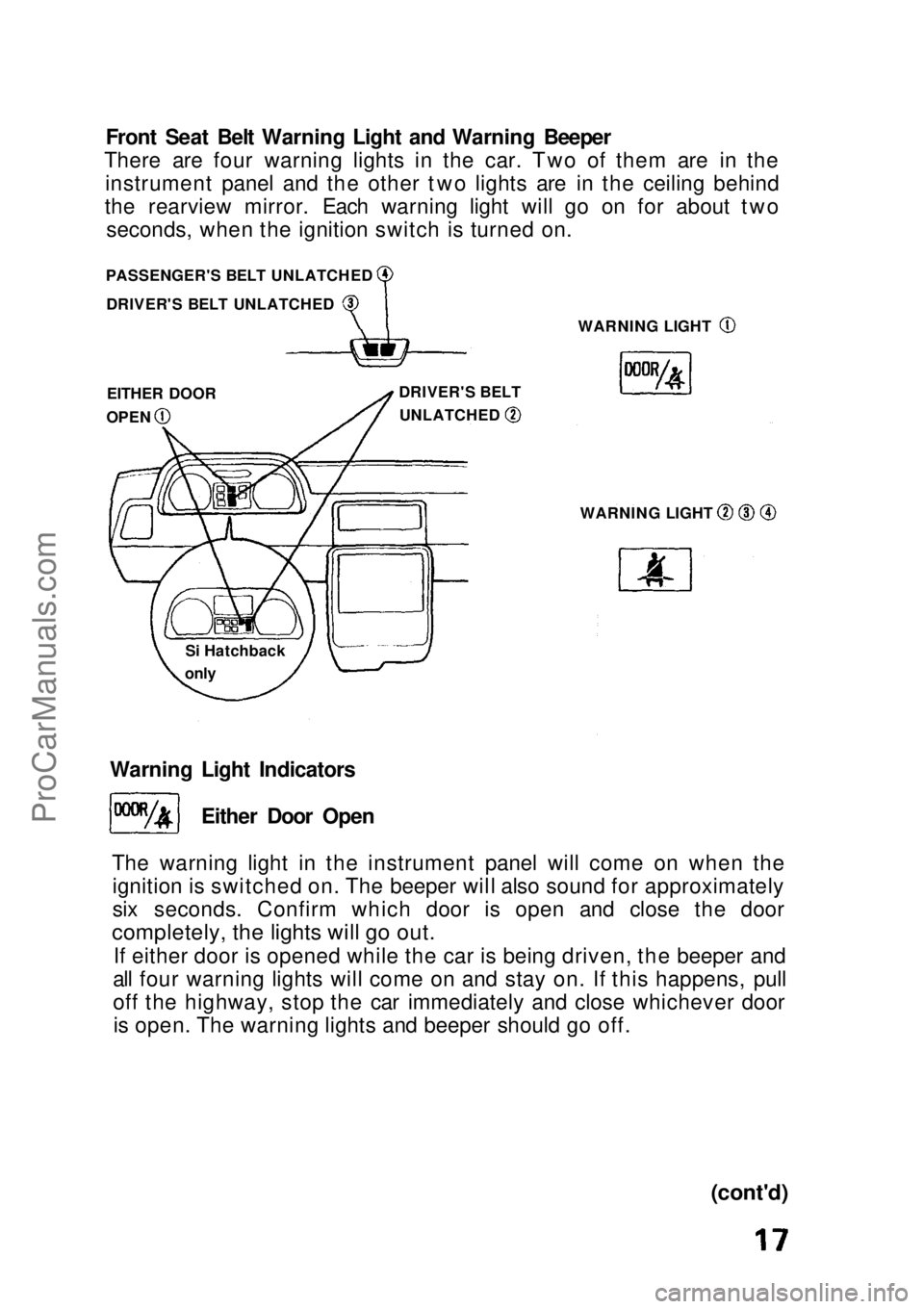
Front Seat Belt Warning Light and Warning Beeper
There are four warning lights in the car. Two of them are in the instrument panel and the other two lights are in the ceiling behind
the rearview mirror. Each warning light will go on for about two seconds, when the ignition switch is turned on.
Warning Light Indicators Either Door Open
The warning light in the instrument panel will come on when the ignition is switched on. The beeper will also sound for approximately
six seconds. Confirm which door is open and close the door
completely, the lights will go out.
If either door is opened while the car is being driven, the beeper and
all four warning lights will come on and stay on. If this happens, pull
off the highway, stop the car immediately and close whichever door is open. The warning lights and beeper should go off.
(cont'd)
PASSENGER'S BELT UNLATCHED
DRIVER'S BELT UNLATCHED WARNING LIGHT
DRIVER'S BELT UNLATCHED
EITHER DOOR
OPEN
WARNING LIGHT
Si Hatchback
onlyProCarManuals.comMain Menu s t
Page 19 of 136
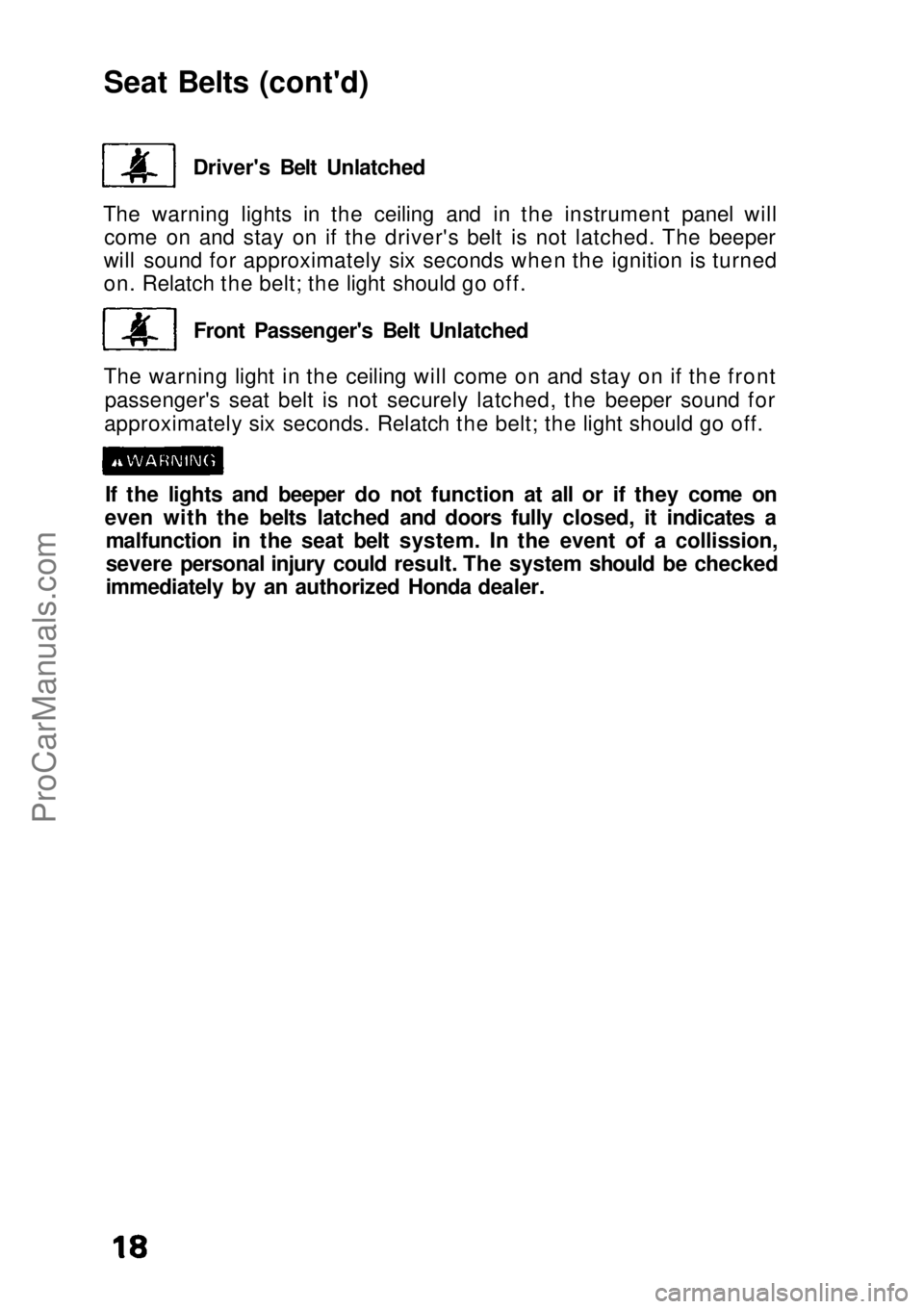
Seat Belts (cont'd)
Driver's Belt Unlatched
The warning lights in the ceiling and in the instrument panel will come on and stay on if the driver's belt is not latched. The beeper
will sound for approximately six seconds when the ignition is turned
on. Relatch the belt; the light should go off.
Front Passenger's Belt Unlatched
The warning light in the ceiling will come on and stay on if the front passenger's seat belt is not securely latched, the beeper sound for
approximately six seconds. Relatch the belt; the light should go off.
If the lights and beeper do not function at all or if they come on
even with the belts latched and doors fully closed, it indicates a malfunction in the seat belt system. In the event of a collission,
severe personal injury could result. The system should be checked
immediately by an authorized Honda dealer.ProCarManuals.comMain Menu s t
Page 30 of 136
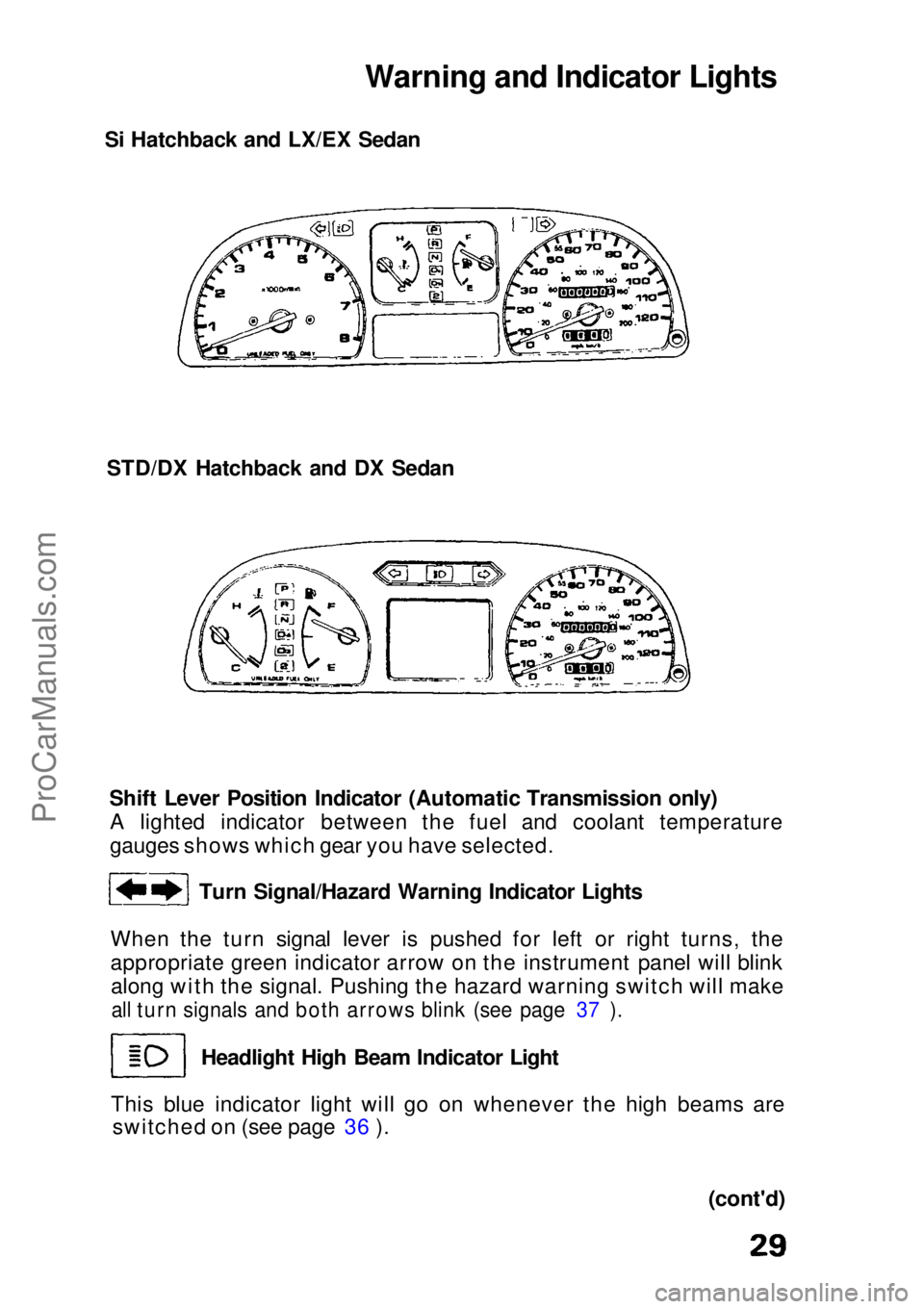
Warning and Indicator Lights
Si Hatchback and LX/EX Sedan
STD/DX Hatchback and DX Sedan
Shift Lever Position Indicator (Automatic Transmission only)A lighted indicator between the fuel and coolant temperature
gauges shows which gear you have selected.
Turn Signal/Hazard Warning Indicator Lights
When the turn signal lever is pushed for left or right turns, the
appropriate green indicator arrow on the instrument panel will blink along with the signal. Pushing the hazard warning switch will make
all turn signals and both arrows blink (see page 37 ).
Headlight High Beam Indicator Light
This blue indicator light will go on whenever the high beams are switched on (see page 36 ).
(cont'd)ProCarManuals.comMain Menu s t
Page 31 of 136
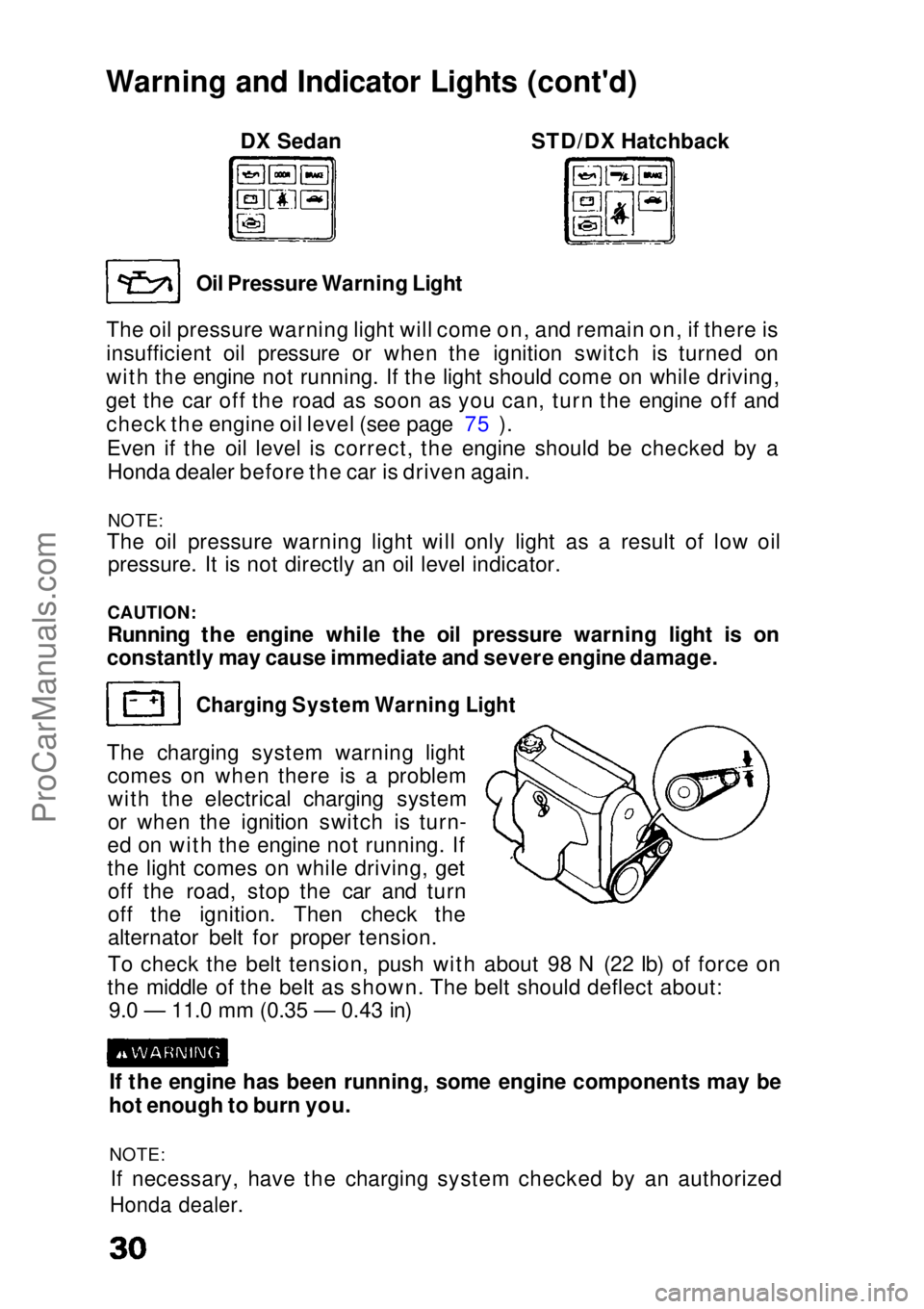
Warning and Indicator Lights (cont'd)
DX Sedan STD/DX Hatchback
Oil Pressure Warning Light
The oil pressure warning light will come on, and remain on, if there is
insufficient oil pressure or when the ignition switch is turned on
with the engine not running. If the light should come on while driving,
get the car off the road as soon as you can, turn the engine off and check the engine oil level (see page 75 ).
Even if the oil level is correct, the engine should be checked by aHonda dealer before the car is driven again.
NOTE:
The oil pressure warning light will only light as a result of low oil
pressure. It is not directly an oil level indicator.
CAUTION:
Running the engine while the oil pressure warning light is on
constantly may cause immediate and severe engine damage.
Charging System Warning Light
The charging system warning light comes on when there is a problemwith the electrical charging system
or when the ignition switch is turn-
ed on with the engine not running. If
the light comes on while driving, get off the road, stop the car and turn
off the ignition. Then check the
alternator belt for proper tension.
To check the belt tension, push with about 98 N (22 Ib) of force on
the middle of the belt as shown. The belt should deflect about: 9.0 — 11.0 mm (0.35 — 0.43 in)
If the engine has been running, some engine components may be
hot enough to burn you.
NOTE: If necessary, have the charging system checked by an authorized
Honda dealer.ProCarManuals.comMain Menu s t
Page 36 of 136
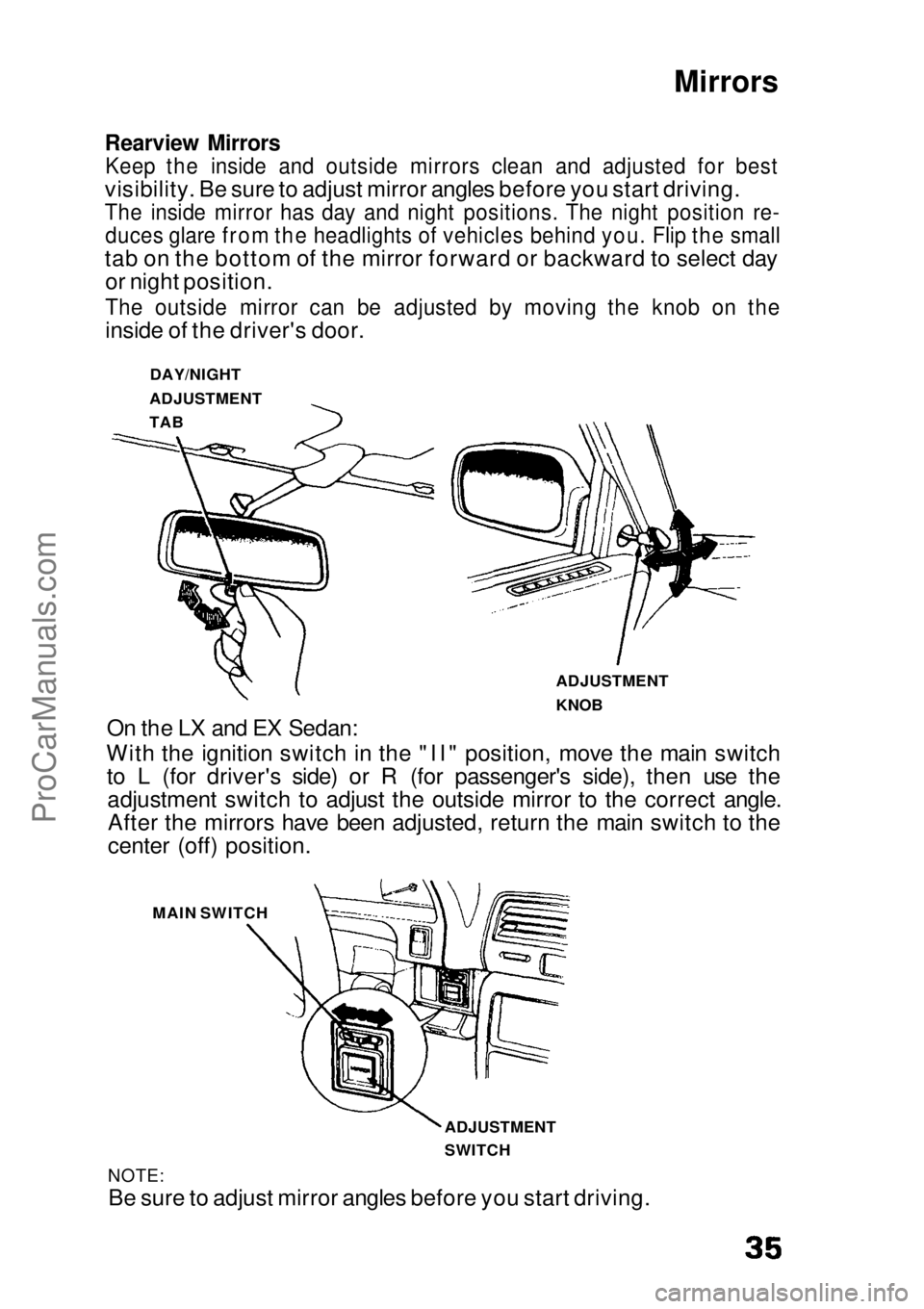
Mirrors
Rearview Mirrors
Keep the inside and outside mirrors clean and adjusted for best
visibility. Be sure to adjust mirror angles before you start driving.
The inside mirror has day and night positions. The night position re-
duces glare from the headlights of vehicles behind you. Flip the small
tab on the bottom of the mirror forward or backward to select day or night position.
The outside mirror can be adjusted by moving the knob on the
inside of the driver's door.
On the LX and EX Sedan:
With the ignition switch in the "II" position, move the main switch to L (for driver's side) or R (for passenger's side), then use theadjustment switch to adjust the outside mirror to the correct angle.After the mirrors have been adjusted, return the main switch to the
center (off) position.
NOTE:
Be sure to adjust mirror angles before you start driving. DAY/NIGHT
ADJUSTMENT
TAB
ADJUSTMENT
KNOB
MAIN SWITCH
ADJUSTMENT
SWITCHProCarManuals.comMain Menu s t
Page 37 of 136
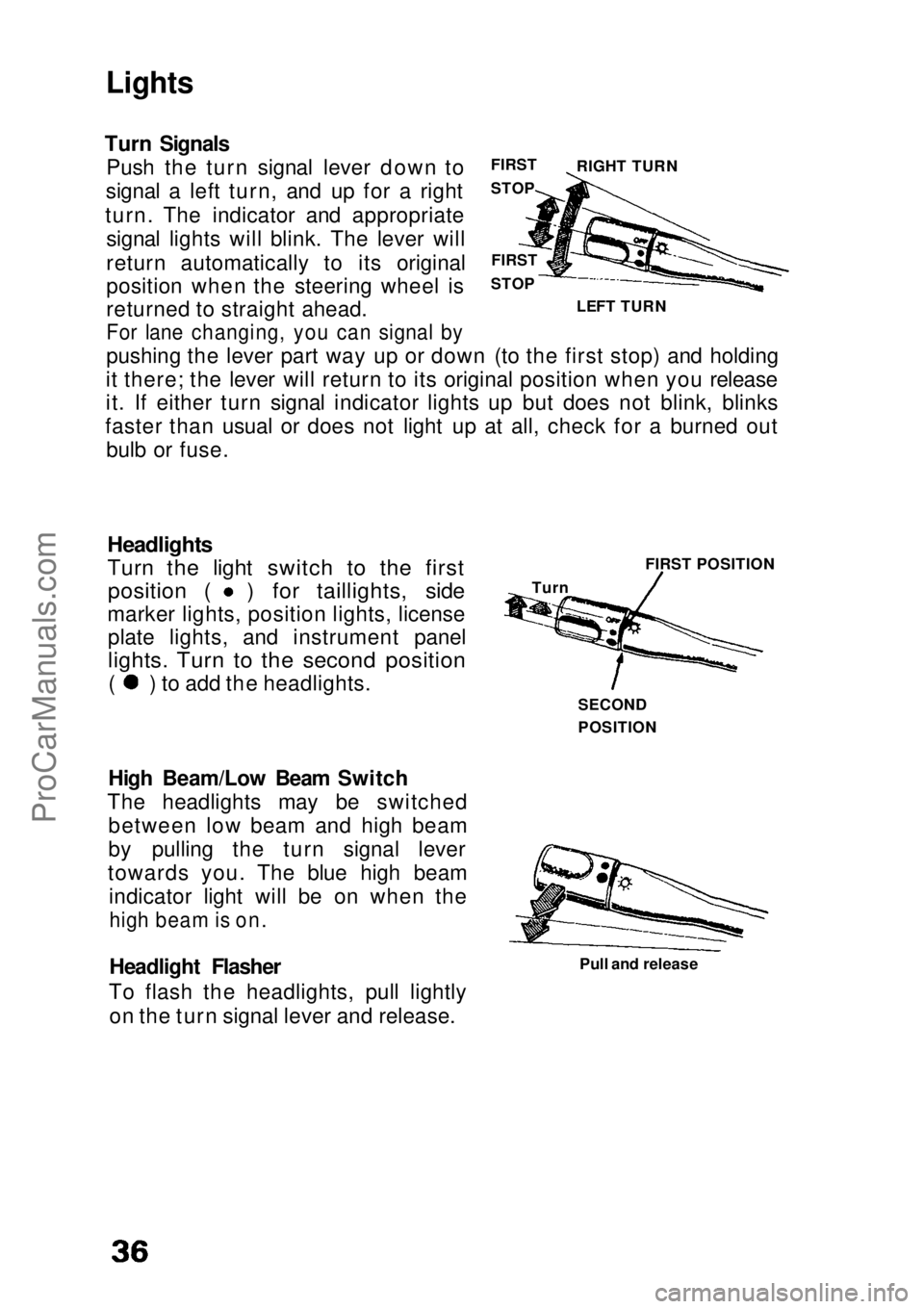
Lights
Turn Signals Push the turn signal lever down to
signal a left turn, and up for a right
turn. The indicator and appropriate signal lights will blink. The lever will
return automatically to its original
position when the steering wheel is
returned to straight ahead.
For lane changing, you can signal by
pushing the lever part way up or down (to the first stop) and holding
it there; the lever will return to its original position when you release
it. If either turn signal indicator lights up but does not blink, blinks
faster than usual or does not light up at all, check for a burned out bulb or fuse.
Headlights
Turn the light switch to the first
position ( ) for taillights, side
marker lights, position lights, license plate lights, and instrument panel
lights. Turn to the second position
( ) to add the headlights.
High Beam/Low Beam Switch
The headlights may be switched between low beam and high beam
by pulling the turn signal lever
towards you. The blue high beam indicator light will be on when the
high beam is on.
Headlight Flasher
To flash the headlights, pull lightly on the turn signal lever and release. Pull and release
FIRST
STOP
FIRST
STOP LEFT TURN RIGHT TURN
Turn FIRST POSITION
SECOND
POSITIONProCarManuals.comMain Menu s t
Page 38 of 136
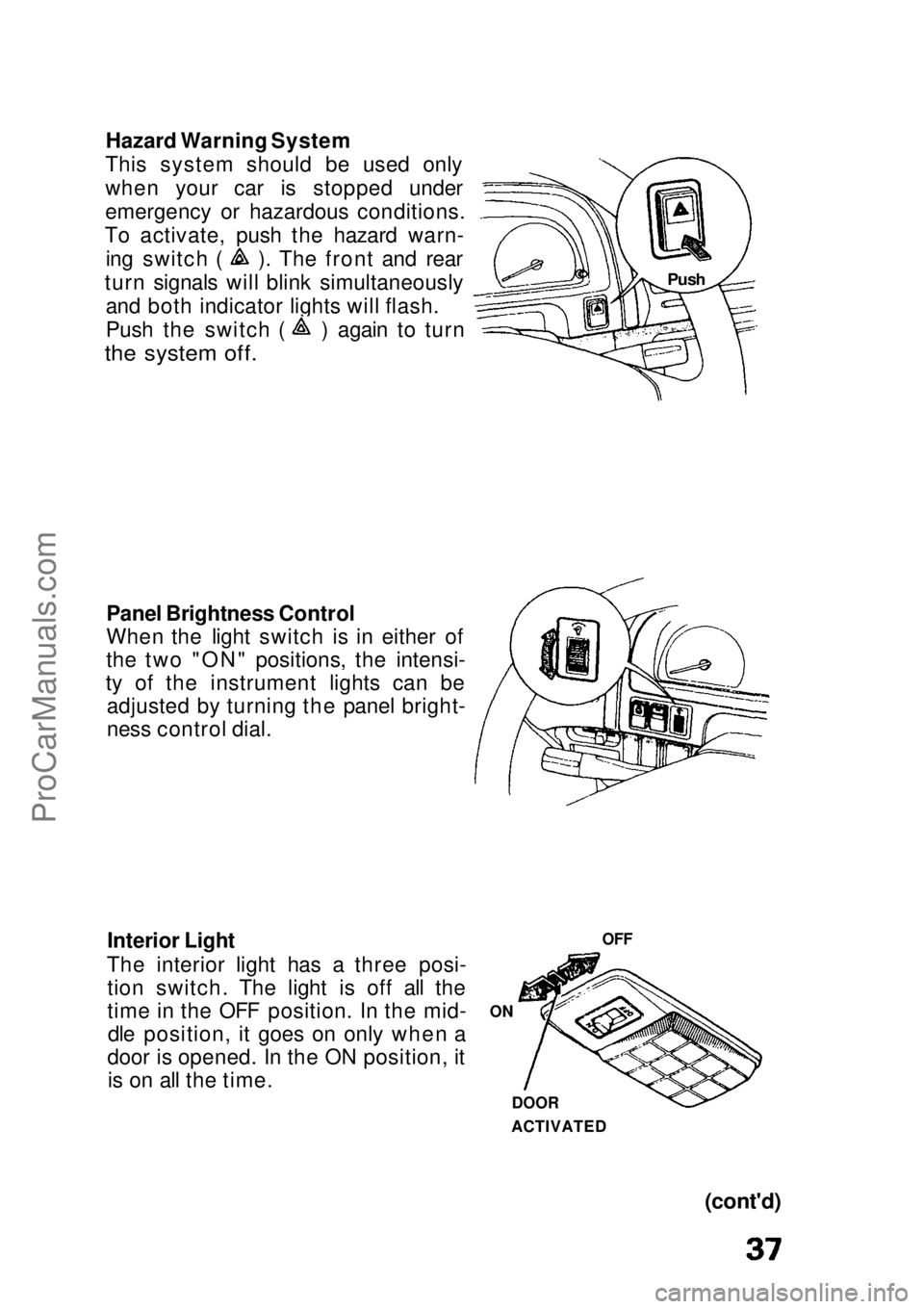
Hazard Warning System
This system should be used only
when your car is stopped under
emergency or hazardous conditions.
To activate, push the hazard warn- ing switch ( ). The front and rear
turn signals will blink simultaneously and both indicator lights will flash. Push the switch ( ) again to turn
the system off.
Panel Brightness Control
When the light switch is in either of
the two "ON" positions, the intensi-
ty of the instrument lights can be adjusted by turning the panel bright-
ness control dial.
Interior Light
The interior light has a three posi- tion switch. The light is off all the
time in the OFF position. In the mid-dle position, it goes on only when a
door is opened. In the ON position, it is on all the time.
(cont'd)
OFF
ON
DOOR
ACTIVATED
PushProCarManuals.comMain Menu s t
Page 39 of 136
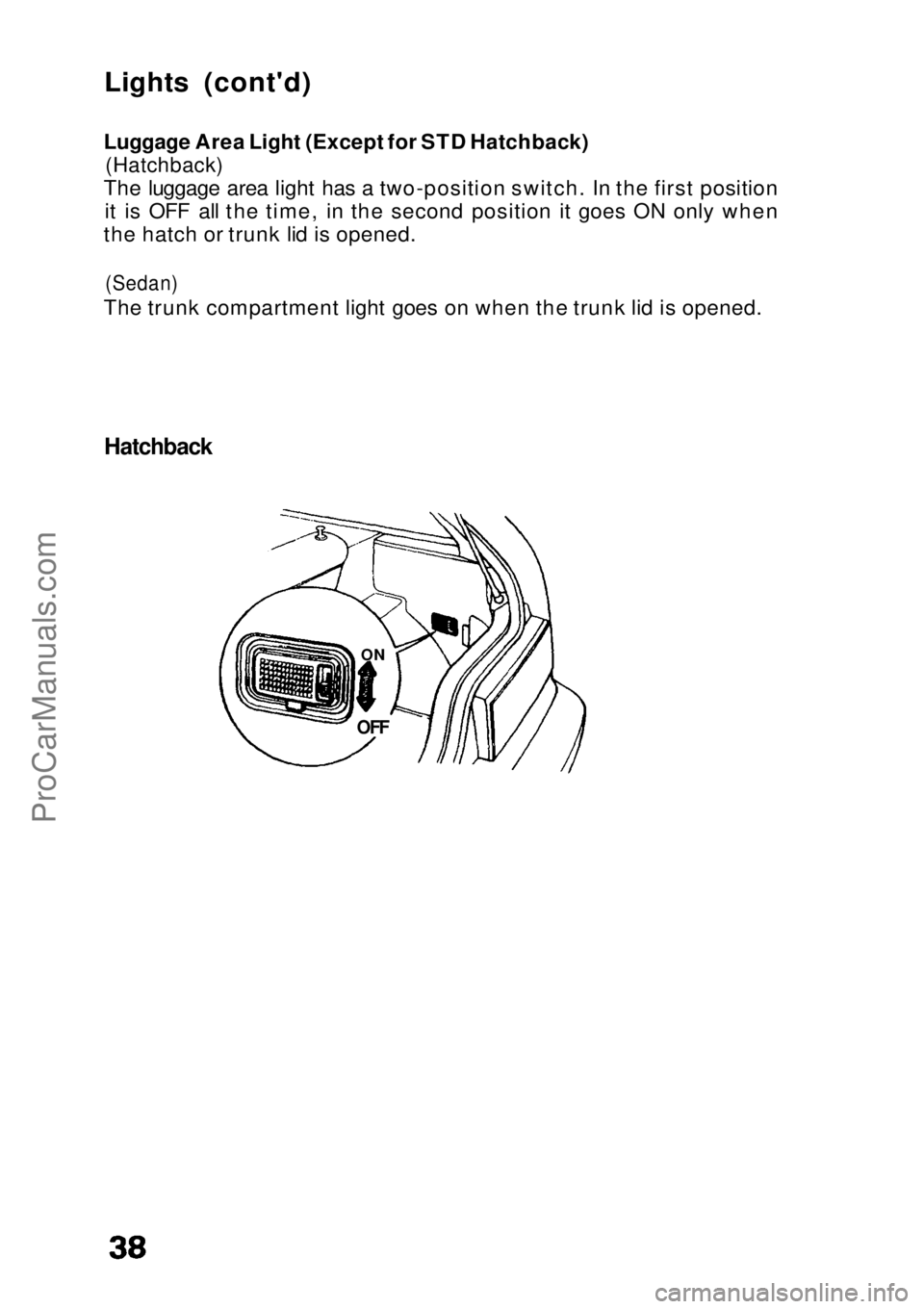
Lights (cont'd)
Luggage Area Light (Except for STD Hatchback)
(Hatchback)
The luggage area light has a two-position switch. In the first position it is OFF all the time, in the second position it goes ON only when
the hatch or trunk lid is opened.
(Sedan)
The trunk compartment light goes on when the trunk lid is opened.
Hatchback
OFF
ONProCarManuals.comMain Menu s t
Page 59 of 136

Starting the Engine
Before Starting
Manual Transmission:
1. Apply the parking brake.
2. Push the clutch pedal all the way in (see NOTE below). 3. Shift the transmission to neutral.
NOTE:
On cars equipped with manual transmissions, the engine will not
crank unless the clutch pedal is fully depressed.
Automatic Transmission:
1. Make sure the shift lever is in Park (P).
2. Apply the parking brake and the foot brake.
NOTE:
When starting in cold weather, keep all unnecessary electrical
circuits off (lights, defogger, etc.) for the best battery output.
Do not crank the engine for more than 15 seconds at a time. Wait
10 seconds before going to the next step.
Starting the Engine 1. With your foot off the accelerator start the engine by turning the key to the III position.
2. If the engine won't start within 15 seconds or starts but fails to continue to run, push the accelerator pedal halfway, and hold it
there while cranking the engine. Once the engine starts, release
the accelerator gradually as the engine speeds up.
3. If it doesn't start within 15 seconds, push the accelerator pedal down to the floor and hold it there while cranking in order to clearflooding. Try step 2 again.
Cold Weather at High Altitude Starting 1. When starting in cold weather at high altitude (above 8,000 feet), push the accelerator pedal about halfway and hold it there while
cranking the engine. Once the engine starts, release the accelerator gradually as the engine speeds up.
2. If it doesn't start within 15 seconds, push the accelerator pedal down to the floor and hold it there while cranking in order to clearflooding. Try step 1 again.
NOTE:
If the outside temperature is below freezing, or if your car has not
been driven for several days, warm up the engine for a few minutes
before driving.ProCarManuals.comMain Menu s t